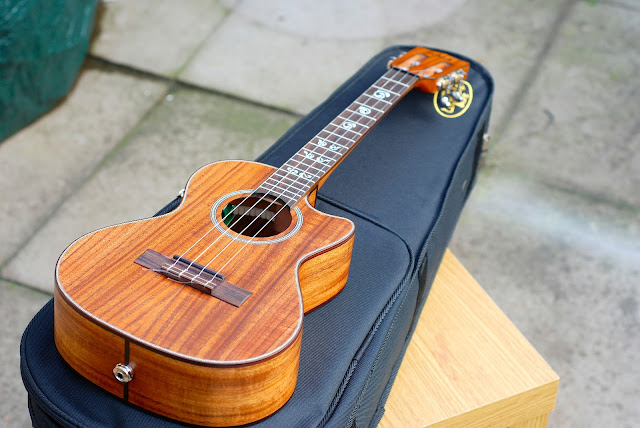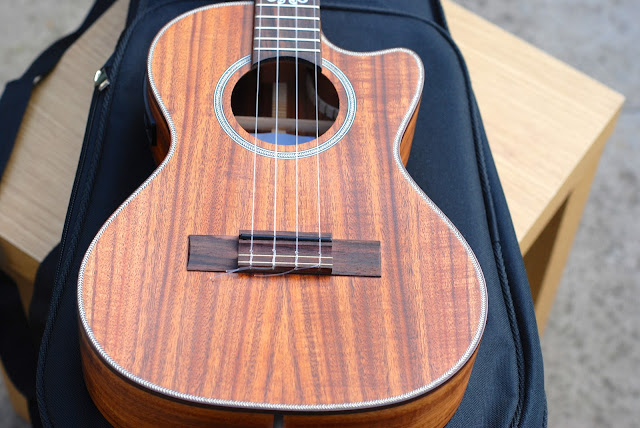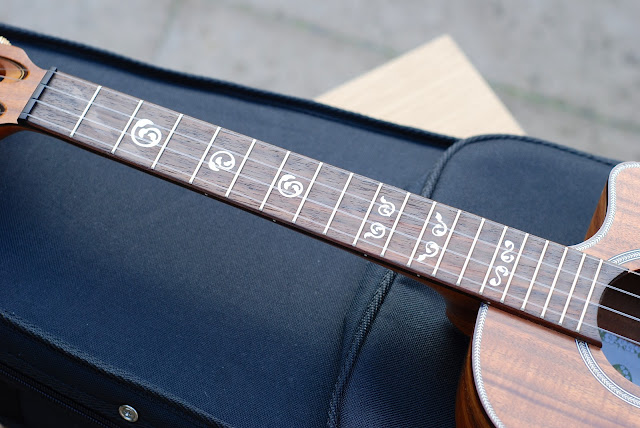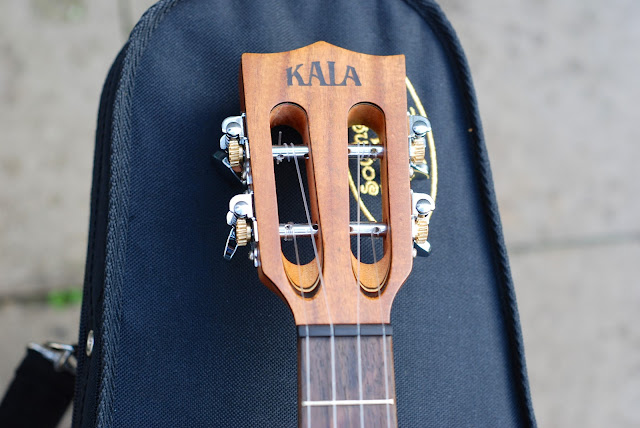Time to kick off 2013 on Got A Ukulele, so what better way than with a new instrument review!
So, with a move for the group I play in to venues that demand us amplifying our instruments, I realised that apart from a solid body uke, I didn't own a true electro acoustic with an active pickup. Say hello to the Kala KA-ASAC-TE/C electro acoustic tenor ukulele! (Commonly called the 'All Solid Acacia')
 |
| Click on images to enlarge - all images copyright Barry Maz 2013 |
This Kala is, at £339, pretty much their top of the line model if you exclude their basses so expectations are perhaps high. Price wise it kind of sits halfway between the cheaper intermediate factory made instruments and Hawaiian or Luthier built models - perhaps alongside the likes of Pono and Mele. This model comes with a cutaway which is (I believe) exclusive to the Southern Ukulele Store from where it came. Some of the features that put it at the top end of the range will become clear as you read on. Their standard model is called the ASAC-TE without the 'C' which just means it has no cutaway. This model can also be bought without the pickup too so there are a range of options with it.
It's a tenor scale uke, with traditional dimensions and shape, with a top back and sides all made of solid Acacia wood - a relative of the Koa tree with a similar stripe in the grain. Overall the body of the uke is flawlessly finished in a satin outer coating. Dare I say it, but the finish is almost a little too perfect? On non-gloss ukuleles I like to be able to see (and feel) some of the pores of the wood grain, but on this uke the finish is so flat that it almost looks like the wood isn't real. That sounds like an odd criticism, but there you go.
The grain though is delightful with some lovely dark stripes on the bookmatched top and back. There is no real curl in the wood grain, or flame, but that isn't expected at this price point. The sides are in two pieces, joined at the butt with some rosewood binding that also edges the joints between the top and back with the sides. On the top that binding is enhanced by some herringbone purfling which I think looks extremely classy - not too 'in your face', but nice all the same. The same herringbone inlay surrounds the sound-hole too.
The bridge mounting is delicate looking and made of rosewood with a small bit of white trim adorning the tie bar behind the saddle. I have seen some of these ukes delivered with eight holes for knot allowing for a 'double hole tie down' method of attaching the strings, though this has only four, therefore requiring the standard looped knot. The saddle itself is made of ebony which is a nice touch. It is uncompensated, and as I regularly say, I am not convinced that on an instrument with the scale length of a ukulele that this is a requirement in any case. Let us put it this way, this instrument tunes and intonates perfectly all over the neck, so it is doing its job!
The back of the uke is slightly arched to help with sound protection, and a quick look inside the body shows a nice and tidy build with no glue spots or wood shavings. The inner kerfling holding the back and top to the sides is notched and nicely fitted. All looking good so far on the build.
Squarely on the butt of the body is the jack socket for plugging the instrument in, which also has an integral strap button. Much nicer to see this rather than a separate jack and me having to fit a separate strap button.
On the top side of the ukulele are the controls for the active pickup. It's a shadow undersaddle active pickup, with a nice small control panel, that houses nothing more than two dials (volume and tone) and a small slot for inserting the cell battery that powers the thing. This means low weight and minimal intrusion into the body cavity or on the side of the instrument.
On to the neck, this is made of mahogany, and is put together from four (count them, four!!) pieces of wood. The heel is stacked from three pieces, and the headstock is also jointed. I would say that is quite excessive for their top of the line model and as we run over the ukulele this is the first sign of a cost cutting element to the instrument. Oh well, does nothing to affect tone or playability, but those joints are visible. The heel of the nut is capped in rosewood to match the tail trim and edge binding.
The fingerboard is made of rosewood, and is edgebound with rosewood also, hiding the fret edges. We have 19 nickel frets with 14 to the body (though that cutaway makes high fret access much easier) and all are set and finished very nicely with no rough edges. The fret markers are one of the standout elements of this ukulele, made of inlaid mother of pearl in a vine or branch type design that differs depending on the fret. I don't much go in for bling but I think these are really nice and give the uke an identity of it's own. Also very pleasing to see side fret markers too, and the markers are in place at the third, fifth, seventh, tenth, twelfth and fifteenth frets. Perhaps a few too many for my liking, but they don't do any harm. Intriguingly, there is no side marker at the third!
Moving past the ebony nut (set and cut nicely) we move on to the next standout design feature of the uke - the slotted headstock. It really is extremely pretty and very nicely finished. The face of the headstock is capped with three or four contrasting layers which means that when the slots were then routed out of the headstock it creates an attractive elongated striped pattern within the slots which I just adore. The Kala logo appears to be very lightly embossed with a dark stain into the face of the headstock which I think looks classy and clean and serves to keep the attention on the rest of the uke. Slots aside, the shape of the headstock follows the ubiquitous three pointed crown seen on so many ukuleles. An important note: the slotted headstock feature only appears on the tenor version of this ukulele, with other all solid acacia models coming with a more standard flat headstock with side mounted tuners.
Tuning is provided by high quality Grover open geared backwards facing tuners with old fashioned shaped buttons which I particularly like. They not only work a treat, but look the part on a headstock like this. But oh, Kala, Kala, Kala.... you had to let me down. One of the tuners is fitted out of line from the others. That makes no difference to how the ukulele works, but it's an attention to detail issue that sets ukes like Kala apart from higher end makers. If a tuner was fitted like this by Kanile'a, it would either not have left the factory, or would have been sold as a B-Stock model. Sure, this is not priced at Kanile'a money, but £339 is no small amount of money for a ukulele.
And that is the package for you - a rather nice looking and, on the whole, finished ukulele. Oh and yes, it comes with Aquila brand strings, but then you probably could have guessed that for yourself......
To hold, the ukulele is nicely balanced and easy to control with or without a strap. It is also relatively light, helped by that minimalist pickup system, so is a joy to play. The feel of that satin finish is certainly nicer on the hand than it is on the eye, and the whole thing feels well made and of premium quality. There are no rough spots, or finish defects anywhere. The neck is a little narrower in width than I normally like, but certainly perfectly normal, and has a quite chunky profile which I think helps offset that for me. It is certainly comfortable to navigate quickly.
Unplugged the uke has a really sweet tone, with good volume balance across the strings. The uke sings, and there are small signs of the sort of harmonic chimes that you see on ukes costing many times more. A very pleasing and clean sound that I am impressed with. It is no K-Brand in tone - played side by side with my Kanile'a K1 it lacks some of the complexity in the harmonics and sounds a little thinner, but that is perhaps an unfair comparison due to the price difference. Compared to the majority of ukes I have played it sounds just great and certainly better than any other Kala I have played. Sustain also is impressive and it delivers that comforting back vibration against the chest long after a strum. The Acacia is certainly doing its job methinks.
One thing the uke doesn't have in spades when unplugged is volume. I would not say the Kala is quiet, but it doesn't throw out a massive punch unless strummed very hard. Let us say the sound is more delicate than brash. That may be improved though with a string change. I swapped out the Aquilas for Living Waters, but may try something like Worth Clear Dense which did a great job of increasing the volume on the Big Island uke I reviewed. That is not a huge criticism though for a couple of reasons. For me tone is more important than out and out volume, and at the end of the day, I bought this to plug it in.
Plugged in and things are, thankfully, extremely sweet. The Shadow pickup, whilst by no means a top of the line system, is extremely clean and natural sounding and I am equally impressed with the amplified sound. The lack of a full 9v battery means it relies solely on a small 1.5v cell battery, and as such the pickup is far from hot. This means you will need to add the gain / volume on the amp or mixer a bit more than you would for a uke with a bigger battery pack, but that is no biggie, and I think that actually helps in keeping the sound clean. There is no imbalance in the strings caused by the pickup, and unlike many electric systems in ukuleles far cheaper, this one actually keeps the uke sounding like a uke through an amp (and not like an electric guitar). For me that is a big plus point often overlooked by those fitting the cheapest pickups they can find.
So all in all, I am impressed. I think it certainly does enough to warrant its top of the line status in the Kala range, although there are those minor issues, like the tuner fitment that show its true heritage. But those aside, it has to come with a recommendation, and this will now likely become my workhorse for live work.
PROS
The look of the wood
Nice subtle but distinctive bling
Great clean pickup system
Sublime looking headstock
CONS
Body finish looks artificial
Tuner fitting not square
A little quiet unplugged
SCORES
Looks - 9.5
Fit and Finish - 8
Sound - 9
Value for money - 9
OVERALL - 8.9
To understand my review scoring and see this result in context - visit my review page at










Thank you for the helpful review. I am considering buying one of these and have not yet been able to try one out. If Southern Music Stores are the only UK retailers I probably wont have a chance to 'play before I buy'. I am guessing that there is no case or gig bag in the price. Once again, thank you.
ReplyDeleteSUS is the only place to get the cutaway, but suspect you may find standard model elsewhere. No, the case is not included, sorry didnt make that clear
ReplyDeleteIn general I'm very disappointed in the workmanship of ukuleles even at this price point. One should not have to pay $2000 to get a decent ukulele. I can buy a passable acoustic/electric guitar from Yamaha, Ibanez or Fender that plays well, sounds good, is plenty loud, intonates to the 15th fret and has straight tuners on it for less than this Kala uke. I don't understand why uke makers can't make a decent uke at an affordable price yet guitar makers can make a very usable guitar without any obvious flaws, such as the flaw in this Kala. It is VERY discouraging to players coming from guitar to uke what these makers are charging for what are obviously second rate instruments. The entry level ukes from most makers are barely playable and others are actually jokes! I've played electric bass since 1968, guitar since 1971. Uke quality is a JOKE.
ReplyDeleteWhilst the tuner placement is irritating, this is an excellent instrument, and thought the review made that clear.
ReplyDeleteI once bought a $1500 dollar Gibson electric from the USA - had it imported. Badly cut nut and an offset tuner. It happens in any factory,
Also, yes, I agree it's irritating that guitar prices don't stack that equally with ukuleles, but the economies of scale massively assist the guitar in this regard.
ReplyDeleteAnd this uke costs nowhere near $2000 and is pretty much perfect I think http://www.gotaukulele.com/2011/08/koaloha-pikake-soprano-ukulele-review.html?m=1
ReplyDeletealso got a mid priced Kala £200+ ish , yes it does sound well but the top does look odd, surface too flat and grain free,it looks like Fablon has been ironed on , but still like some of the Kala ukes !!
ReplyDeleteI took delivery of one of these yesterday.No issues at all, totally delighted all round, amazing sound, both plugged in and unplugged . The tuners are all in line, and not a flaw to be seen.The acacia is somewhat darker than Barry's model, but still very attractive. I am totally thrilled with this Uke , and it is certainly top of my growing Uke collection. I think that this Uke will keep me satisfied for a long time now, to the delight of my wife.
ReplyDeleteBarry - I have been offered a KA-ASAC-T (ie non electro) for under £200 and am sorely tempted - list price I know is £299 and this one has a couple small marks that don't affect the playing. What do you reckon for an improver (just) like me ?
ReplyDeleteJim
Jim - I must say, as much as I love this uke and play it live regularly, the unplugged sound is not the greatest. Don't get me wrong, it's decent enough, but not a lot of volume, and think you can do better on a purely acoustic tenor for the money
ReplyDeleteI have had mine now (acoustic) for a year now and absolutely love it! Sound and playability are tops! Looks great with no flaws and holds tune perfect! Wish I would have got it a long time ago.
ReplyDeleteWhere could I buy this Kala KA-ASAC-TE/C Electro Tenor Ukulele? I really felt in love with it and I'm not able to find it!!! Writing from Spain... Thank you!!
ReplyDeleteBought mine from Southern Ukulele Store in UK
ReplyDeleteDoes it have the same sound projection as the acoustic one? I had a go on the acoustic one yesterday and it seems pretty loud to me but I'm not an expert. I play in an acoustic band but I want electric for the future because I've started doing a lot of gigs recently. What do you think is better, for the price, for non-electric?
ReplyDeleteYeah, it's plenty loud unplugged
ReplyDeleteGreat review. Have you settled on a set of strings that you like best with it yet?
ReplyDeleteI did end up with Worth CD strings, but since have sold the uke.
ReplyDeleteWhat did you get in place of this uke?
ReplyDelete:)
I moved to a Pono Tenor with a passive pickup
ReplyDelete